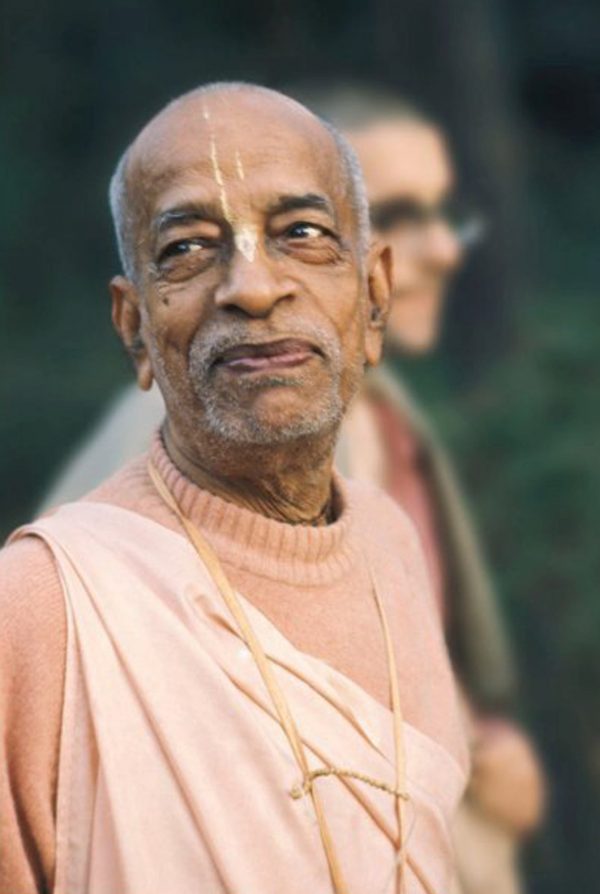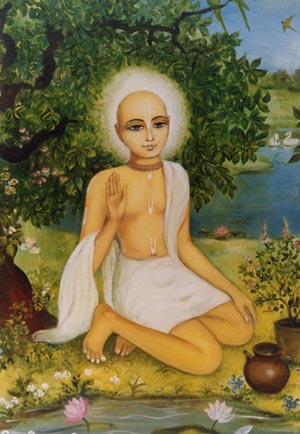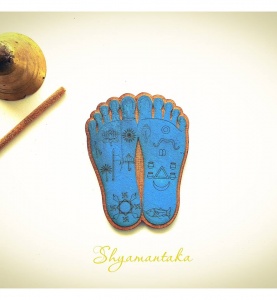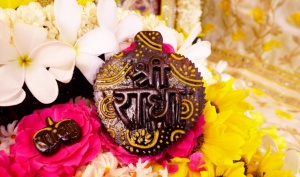Šri Hit Čaurasi,- Šri Hita Harivanšo Mahaprabhu poezijos/ maldų rinkinys. Šią knygą sudaro 84 eiliuoti tekstai. Šiame įraše dalinuosi lietuvišku 10- osios maldos “Stulbinanti pora džiugina širdį!” āju nāgarī-kishor bhānvatī vichitra jor lietuvišku bei anglišku vertimu.
Stulbinanti pora džiugina širdį! āju nāgarī-kishor bhānvatī vichitra jor | Šri Hit Čaurasi (10-oji malda)
āju nāgarī-kishor bhānvatī vichitra jor,
kahā kaho ang-ang param mādhurī [1]
Šiandien stulbinanti pora, sumani Dama ir Jaunuolis džiugina širdį. Ką aš galiu pasakyti apie neapsakomą Jų saldumą!
“Today the astonishing couple, that Clever Lady and the Youth are very pleasing to the heart. Just what can I say regarding the indescribable sweetness of their limbs!?”
nāgara m. a clever or intriguing woman
karat keli kanth meli bāhudand gand-gand,
paras saras rās-lās mandalī jurī [2]
Sudėję rankas vienas kitam per kaklą, prisiglaudę skruostais, Jie žaismingai (ir tuo pat metu labai elegantiškai) įsisuka į Rasos šokio ratą.
“Placing their arms around each other’s necks, with their faces cheek against cheek absorbed in play, they join the elegant circle in the Rasa-dance.”
shyāmsundarī bihār bānsurī mridang tār,
madhur ghosh nupurādi kinkinī churī [3]
Šioje Šjamos (Krišnos) ir Gražuolės (Radhos) liloje skamba saldūs fleitos, mrindangų ir karatalų garsai…kuriuos papildo varpelių esančių ant apyrankių (kulkšnių ir rankų) ir diržų skambesys.
“In the play of Shyam and the Beautiful one, the sweet sounds of flute, drum and cymbal are heard, along with anklets, belts with tiny tinkling bells and bangles”
That Shyamghan [dark-raincloud-like Hari] and that beauty Sri Radha’s love play is going on in this way. The sweet sounds of instruments such as the flute, mridanga drum and sarangi are heard and are mixed in with the tinkling of anklets, waist-belts and bangles.
The ancient commentators, Rasiklalji and Premdasji give the meaning of ‘tār’ as ‘karatāl’ [cymbals] whilst Dharanidhara-dasji and Lokanathji retain ambiguity.
(jay shrī) dekhat harivansh āli, nirtanī sudhang chāl,
vāri pher deyt prān deha-so durī [4]
Šri Hita Harivanšas (sakės formoje) matydamas nuostabius šokio judesius lieka pakerėtas; Jis (Harivanšas) netenka žado ir net nebegali kvėpuoti (Šri Harivanšas Mahaprabhu aukoja savo gyvenimą vėl ir vėl).
“Sri Hit Harivansh, the hidden [within a human form] Sakhi, sees the Lovely movements of the sudhanga1 dance and sacrifices her body’s breath.”
‘sudhanga-dance’ – sudhanga appears frequently in the writings of Sri Harivansh and in that of his contemporaries such as Sri Harirama Vyasa and Sri Surdas. It is a dance form performed with graceful, suggestive body postures and movements. Surdas mentions it in ‘nachat sudhang sri nanda-nandan’ and Harirama mentions it in ‘natava nainasudhanga dikhavata’ etc. Furthermore, Sudhang is a colloquial way of saying ‘shuddha ang’ or pure dance.

Hiding within a human form [Sri Shyama-Shyam’s eternal sahachari/sakhi] Sri Harivansh sakhi is viewing this beautiful dance full of astonishing movements and becoming overwhelmed [“with a choked throat”] with bliss, she is offering her life-airs [prana] to this delightful play of theirs.
Note by Sri Lalitcharan Goswami: Some commentators have given the meaning of ‘deha sau duri’ as ‘hiding within the bushes/shrubs of the kunja”. However, the sakhis only do this when Sri Priya-Lalju are engaged in sringara-keli[lovemaking lilas]. This pada describes their rāsa lila instead and therefore there is no need for the sakhis to be amidst the vines/bushes at this time. All of the sahacharis [sakhis] take part in some way or another in the play of the rāsa lila [rāsa-keli]. Therefore the proper meaning of ‘deha sauduri’ must be as I have explained.
COMMENTARY OF SRI HITDASJI MAHARAJA [where different]: Seeing the swift dancing movements of that Sri Radha, who is adept in the art of dance, Sri Hit-Alibeing intoxicated with the rasa of her [Sri Radha’s] bodily splendour, surrenders her life again and again.

COMMENTARY OF SRI LALITCHARAN GOSWAMI BHUMIKA [introduction]:Sri Yugal’s rāsa-lila-play amidst the group of sakhis [sakhi-mandali] is described in this pada. This rāsa lila dance is different to the famous rāsa lila that takes place at Vanshivat and is instead connected to Shyama Shyam’s eternal loving plays [rāsa-vilasa]. Within the depths of the experience of divine love [prema], there is a state where dancing [nritya], singing [sangita] etc. are naturally performed along with their numerous varieties and associated activities. All of this nourishes the growth of prema. Sri Shyama-Shyam are directly the very forms of prema and their mutual prema for one another always naturally flows and spreads with the ever-dynamic movements of their lila. The appearance of their jubilation in prema [premollasa] naturally takes place during the rāsa lila. This pada describes that spontaneously occurring rāsa lila. In today’s rāsa lila, the display of Sri Shyama-Shyam’s limbs and dancing merriment have caused astonishing waves of physical beauty. Seeing this sight [darshan], Hit Sajani being situated within a human form [as Acharya Sri Hit Harivansh] has become mad in ecstatic bliss and within that condition has described the rāsa lila as follows: COMMENTARY OF SRI HITDASJI MAHARAJA AVATARANA [introduction]: After the completion of dressing them up in the inner courtyard [madhya-griha], Sri Yugal-Kishorare absorbed in the rasa of their rāsa lila wherein accompanying their dancing are other features resounding such as many types of sweet rhythms, singing voices, musical instruments etc. Seeing Sri Radha’s extremely expert dancing movements, all of the Sahacharis’ hearts are astonished and surrender themselves to her.
Verčiau remdamasis Hari-Radhacharan das (https://sriharivansh.wordpress.com/sri-hit-chaurasi-84-songs-of-sri-harivansh-mahaprabhu/ (anglišką vertimą taip pat pridedu)) ir Pratibha Goswami (knygos: Hit Chaurasi- the 84 hymns of Divine Love) angliškais vertimais, bei sanskrito kalbos žodynu (https://sanskritdictionary.com/).
Daugiau Šri Harivanšo poezijos (išverstos lietuviškai) galite rasti:
https://evaldas-palskys.lt/ciategory/vertimai/sri-hit-caurasi/
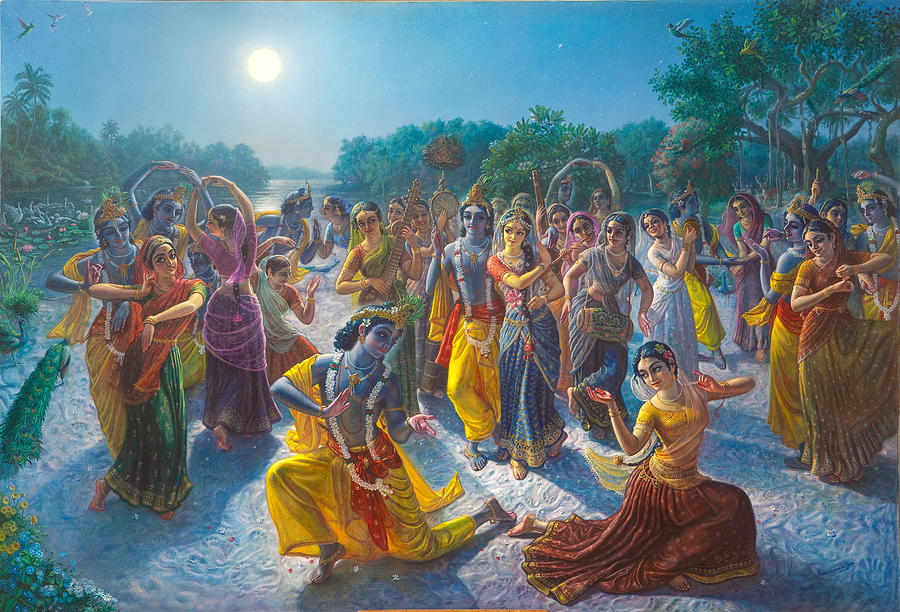
https://www.youtube.com/watch?v=_uqpnSX2l7Q
Shri hit Chaurasi Pad No. 10 || आजु नागरी किशोर भांवती विचित्र जोर।
https://www.youtube.com/watch?v=uttaBPTgvKo&t
श्री हित चौरासी जी – संगीत सहित पद गायन ( पद संख्या 9-11 ) // Shri Hit Radha Keli Kunj


